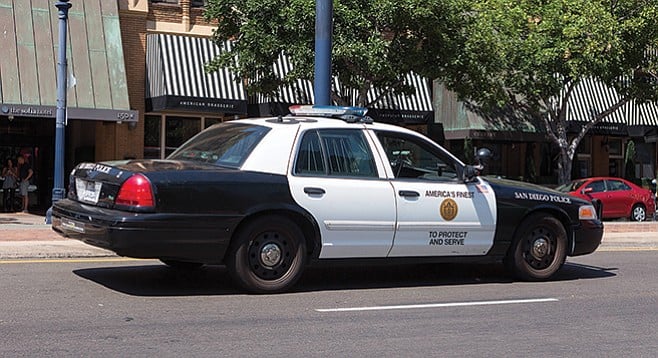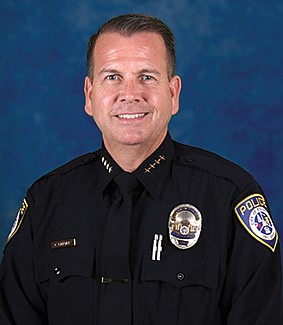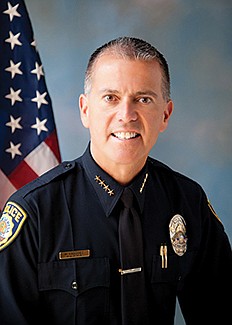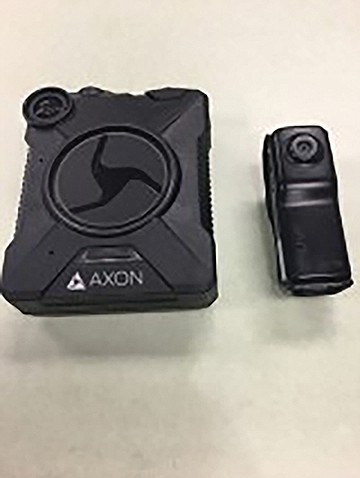 Facebook
Facebook
 X
X
 Instagram
Instagram
 TikTok
TikTok
 Youtube
Youtube

The 2015–2016 San Diego County Grand Jury Report on Citizen Oversight Boards of Police Behavior issued on May 25 recommended that seven cities establish citizen review boards or consider establishing regional boards. Jurors suggested that one board could oversee complaints in Escondido, Oceanside, and Carlsbad; another could serve El Cajon and La Mesa; and a third could combine Coronado and Chula Vista with the existing National City board.
The report began with the statement that jurors “investigated several citizen complaints regarding police officer behavior in local jurisdictions and found there are differing methods for handling citizen complaints.” The report acknowledged that local jurisdictions met “California requirements for reviewing complaints” and stated “there are two models” for boards: the City of San Diego Citizens’ Review Board and the County of San Diego Citizens’ Law Enforcement Review Board.
The report recommended that the city and county “provide limited compensation for board member time and involvement” and that the city “provide independent legal counsel” to the board. “Interviewed officials expressed dissatisfaction with the legal services provided by the office of the city attorney [the board’s legal counsel]. The city attorney also defends the police department, creating a potential conflict of interest,” the report stated.

People interviewed by the jury included members of both boards, San Diego councilmembers, and police chiefs. On April 11, Escondido police chief Craig Carter spoke to jurors for approximately 90 minutes. “The questions centered on policies and procedures,” he said on September 20. Carter, president of the San Diego County Police Chiefs and Sheriffs Association, also spoke to jurors about the Peace Officer Bill of Rights and community outreach.
On July 19, the county board of supervisors approved chief administrative officer Helen Robbins-Meyer’s response to the report that maintained “modest compensation” would “encourage greater community involvement and increase board diversity.” Robbins-Meyer countered that the county pays for travel expenses. “It does not appear that additional compensation is needed to increase board diversity and community involvement.”
The county’s review board established in 1990 investigates complaints against sheriff’s deputies and probation officers. The board “handles about 125 to150 cases each year,” county spokesperson Tammy Glenn said on September 21.
The 23 cases on the September 13 agenda included a man’s complaint that a deputy “allegedly did not take the complainant’s grievance/complaint, saying there were no forms.” The board found the deputy’s action justified because the deputy “verbally accepted his complaint by offering to have a sergeant come to the station and meet with him concerning this matter.”
Another complainant alleged that a deputy “repeatedly failed to respond to numerous grievances pertaining to separate housing of transgender inmates and their lack of programs.” Documentation included grievances filed between July 3–8, 2015. The board sustained the complaint.
While tracking responses, I asked city officials about the number of complaints. Jurors made no recommendation about National City (population 61,060 according to the 2010 census). The National City Community and Police Relations Commission was established in October 2003. According to May 19 minutes, commissioners unanimously supported police-department findings in three cases. A fourth case was withdrawn.
In Coronado (population 24,812), the city council on July 19 approved mayor Casey Tanaka’s letter that said the police department received an “84 percent positive rating” in a 2014 National Research Center survey of residents. Tanaka pointed out that jurors didn’t specify the locations where citizens complained. The grand jury had not responded at press time to the Reader’s phone messages about the number of complaints and locations.

Coronado police chief Jon Froomin said September 19 that there were five complaints in 2014, nine in 2015, and six so far in 2016. “Cities handle [complaints] differently. I play it fairly safe” when classifying an incident as a formal complaint. Grievances include the person who complained about being arrested. That person received a letter that said, “You were never arrested. You were detained and let go.”
Another complaint was from a driver who said, “I think it’s unfair that the officer gave me a parking ticket.” Asked why this was unfair, the driver referred to other cars that weren’t ticketed.

In a September 19 interview, La Mesa (population 60,089) police chief Walt Vasquez elaborated on his statements at the July 26 council meeting. The council rejected formation of a board after Vasquez spoke about the city’s low complaint total and methods of communication ranging from Coffee with a Cop events to social media.
In the interview, Vasquez said five complaints were filed in 2015. The 2016 year-to-date total was two complaints. At community forums, Vasquez said the most common concerns “are traffic-related, speeding and the volume of cars, and transients.”
The one police-related concern raised by residents was Vasquez’s response to the question, “Can you put a police officer at the intersection [on a longterm basis]?” “I can’t do that,” he said.
Social media includes the police department’s Facebook page, and Vasquez said his phone number and an email link are on department web page. “People can email directly or call with a concern, question, or complaint — or if they have a compliment, there’s a form [on the page] to commend an officer or civilian employee.”
The San Diego County Grand Jury extended the City of San Diego’s (population 1,394,928) response deadline to October 28, mayor Kevin Faulconer’s press secretary Jen Lebron said on August 3. The review required for the response and the city’s August legislative recess prompted the extension, she explained.
San Diego’s board was established in 1988, and, Lebron said there were 63 Category 1 complaints in 2015 — issues pertaining to an “arrest, criminal conduct, discrimination, force, and use of ethnic/racial slurs.” There were also 87 Category 2 complaints, which pertain “to conduct, courtesy, procedure, and service.”
In Carlsbad (population 113,453), 12 citizen complaints were filed in 2015, communications manager Kristina Ray said in an August 5 email. A public records request yielded an August 3 letter rejecting formation of a board. That recommendation was also rejected by city councils in El Cajon on August 9 and Oceanside on August 10, and in Escondido city manager Graham Mitchell’s August 16 letter.
In El Cajon (population 103,679), police internal affairs lieutenant Rob Ransweiler said on July 28 (two months before an El Cajon police office shot and killed Alfred Olango, sparking five nights of demonstrations) that one citizen complaint was filed in 2016; there was one complaint in 2015, two in 2014, and eight in 2013.
An August 10 records request in Oceanside (population 175,691) showed 14 internal complaints and one external complaint in 2014. In 2015, there were 15 internal complaints and one external complaint. As of August 10, there were seven internal complaints and six external complaints.
In Escondido (population 151,451), Carter said there were 22 complaints in 2015 and 11 complaints year-to-date in 2016. Outreach includes partnering with the Escondido Education COMPACT for activities like an August 10 police town hall. Residents were surveyed before and after the event, and 51 percent agreed with the statement “the police understand the problems in my neighborhood.”
In Chula Vista (population 265,757), the police department received 44 formal misconduct complaints in 2015, according to mayor Mary Casillas Salas’s August 16 letter. She maintained there was “no demonstrated need” for an oversight board. The total included 12 citizen complaints and most complaints were “low level, such as discourtesy or failure to file a police report.”
The mayor wrote that the council adopted a 2001 citizen task force recommendation to establish the Chief’s Advisory Committee that meets on “matters related to public safety and community-related issues.”
Furthermore, the police department in 2016 purchased an “early warning” software system to track citizen complaints. The system also tracks officer conduct in areas such as “use of force, pursuits, collision [and] traumatic incidents.”

Salas, Carter, and Froomin said their cities (Chula Vista, Escondido, and Coronado) were among the first in the county to equip officers with body-worn cameras. Carter said Escondido issued cameras to patrol officers in 2010. After Carter became chief in 2013, he worked to outfit all officers with cameras in early 2014. “In any situation, there’s one side, the other side, and somewhere in the middle,” and cameras help resolve the matter.
Froomin said a resident’s complaint that an officer “falsely entered” the home was resolved when footage showed “you were at the door and let” the officer in.
On September 28, the San Diego City Council’s Public Safely and Livable Neighborhoods Committee was set to discuss rejection of jury recommendations. The proposed response stated the city attorney’s office provided legal services since 1988 “without the incidence of a conflict of interest. In Fiscal Year 2017, the city budgeted $25,000 for outside legal counsel…in the event a conflict of interest arises.”
As for pay, compensation “runs counter to the volunteer board concept,” and board members can park for free in the Evan Jones Parkade.
Committee recommendations would be forwarded to the council, Lebron said.
Furthermore, Measure G on the November 8 ballot changes the panel name to the “Community Review Board on Police Practices” and requires review of in-custody deaths and officer-involved shootings.


The 2015–2016 San Diego County Grand Jury Report on Citizen Oversight Boards of Police Behavior issued on May 25 recommended that seven cities establish citizen review boards or consider establishing regional boards. Jurors suggested that one board could oversee complaints in Escondido, Oceanside, and Carlsbad; another could serve El Cajon and La Mesa; and a third could combine Coronado and Chula Vista with the existing National City board.
The report began with the statement that jurors “investigated several citizen complaints regarding police officer behavior in local jurisdictions and found there are differing methods for handling citizen complaints.” The report acknowledged that local jurisdictions met “California requirements for reviewing complaints” and stated “there are two models” for boards: the City of San Diego Citizens’ Review Board and the County of San Diego Citizens’ Law Enforcement Review Board.
The report recommended that the city and county “provide limited compensation for board member time and involvement” and that the city “provide independent legal counsel” to the board. “Interviewed officials expressed dissatisfaction with the legal services provided by the office of the city attorney [the board’s legal counsel]. The city attorney also defends the police department, creating a potential conflict of interest,” the report stated.

People interviewed by the jury included members of both boards, San Diego councilmembers, and police chiefs. On April 11, Escondido police chief Craig Carter spoke to jurors for approximately 90 minutes. “The questions centered on policies and procedures,” he said on September 20. Carter, president of the San Diego County Police Chiefs and Sheriffs Association, also spoke to jurors about the Peace Officer Bill of Rights and community outreach.
On July 19, the county board of supervisors approved chief administrative officer Helen Robbins-Meyer’s response to the report that maintained “modest compensation” would “encourage greater community involvement and increase board diversity.” Robbins-Meyer countered that the county pays for travel expenses. “It does not appear that additional compensation is needed to increase board diversity and community involvement.”
The county’s review board established in 1990 investigates complaints against sheriff’s deputies and probation officers. The board “handles about 125 to150 cases each year,” county spokesperson Tammy Glenn said on September 21.
The 23 cases on the September 13 agenda included a man’s complaint that a deputy “allegedly did not take the complainant’s grievance/complaint, saying there were no forms.” The board found the deputy’s action justified because the deputy “verbally accepted his complaint by offering to have a sergeant come to the station and meet with him concerning this matter.”
Another complainant alleged that a deputy “repeatedly failed to respond to numerous grievances pertaining to separate housing of transgender inmates and their lack of programs.” Documentation included grievances filed between July 3–8, 2015. The board sustained the complaint.
While tracking responses, I asked city officials about the number of complaints. Jurors made no recommendation about National City (population 61,060 according to the 2010 census). The National City Community and Police Relations Commission was established in October 2003. According to May 19 minutes, commissioners unanimously supported police-department findings in three cases. A fourth case was withdrawn.
In Coronado (population 24,812), the city council on July 19 approved mayor Casey Tanaka’s letter that said the police department received an “84 percent positive rating” in a 2014 National Research Center survey of residents. Tanaka pointed out that jurors didn’t specify the locations where citizens complained. The grand jury had not responded at press time to the Reader’s phone messages about the number of complaints and locations.

Coronado police chief Jon Froomin said September 19 that there were five complaints in 2014, nine in 2015, and six so far in 2016. “Cities handle [complaints] differently. I play it fairly safe” when classifying an incident as a formal complaint. Grievances include the person who complained about being arrested. That person received a letter that said, “You were never arrested. You were detained and let go.”
Another complaint was from a driver who said, “I think it’s unfair that the officer gave me a parking ticket.” Asked why this was unfair, the driver referred to other cars that weren’t ticketed.

In a September 19 interview, La Mesa (population 60,089) police chief Walt Vasquez elaborated on his statements at the July 26 council meeting. The council rejected formation of a board after Vasquez spoke about the city’s low complaint total and methods of communication ranging from Coffee with a Cop events to social media.
In the interview, Vasquez said five complaints were filed in 2015. The 2016 year-to-date total was two complaints. At community forums, Vasquez said the most common concerns “are traffic-related, speeding and the volume of cars, and transients.”
The one police-related concern raised by residents was Vasquez’s response to the question, “Can you put a police officer at the intersection [on a longterm basis]?” “I can’t do that,” he said.
Social media includes the police department’s Facebook page, and Vasquez said his phone number and an email link are on department web page. “People can email directly or call with a concern, question, or complaint — or if they have a compliment, there’s a form [on the page] to commend an officer or civilian employee.”
The San Diego County Grand Jury extended the City of San Diego’s (population 1,394,928) response deadline to October 28, mayor Kevin Faulconer’s press secretary Jen Lebron said on August 3. The review required for the response and the city’s August legislative recess prompted the extension, she explained.
San Diego’s board was established in 1988, and, Lebron said there were 63 Category 1 complaints in 2015 — issues pertaining to an “arrest, criminal conduct, discrimination, force, and use of ethnic/racial slurs.” There were also 87 Category 2 complaints, which pertain “to conduct, courtesy, procedure, and service.”
In Carlsbad (population 113,453), 12 citizen complaints were filed in 2015, communications manager Kristina Ray said in an August 5 email. A public records request yielded an August 3 letter rejecting formation of a board. That recommendation was also rejected by city councils in El Cajon on August 9 and Oceanside on August 10, and in Escondido city manager Graham Mitchell’s August 16 letter.
In El Cajon (population 103,679), police internal affairs lieutenant Rob Ransweiler said on July 28 (two months before an El Cajon police office shot and killed Alfred Olango, sparking five nights of demonstrations) that one citizen complaint was filed in 2016; there was one complaint in 2015, two in 2014, and eight in 2013.
An August 10 records request in Oceanside (population 175,691) showed 14 internal complaints and one external complaint in 2014. In 2015, there were 15 internal complaints and one external complaint. As of August 10, there were seven internal complaints and six external complaints.
In Escondido (population 151,451), Carter said there were 22 complaints in 2015 and 11 complaints year-to-date in 2016. Outreach includes partnering with the Escondido Education COMPACT for activities like an August 10 police town hall. Residents were surveyed before and after the event, and 51 percent agreed with the statement “the police understand the problems in my neighborhood.”
In Chula Vista (population 265,757), the police department received 44 formal misconduct complaints in 2015, according to mayor Mary Casillas Salas’s August 16 letter. She maintained there was “no demonstrated need” for an oversight board. The total included 12 citizen complaints and most complaints were “low level, such as discourtesy or failure to file a police report.”
The mayor wrote that the council adopted a 2001 citizen task force recommendation to establish the Chief’s Advisory Committee that meets on “matters related to public safety and community-related issues.”
Furthermore, the police department in 2016 purchased an “early warning” software system to track citizen complaints. The system also tracks officer conduct in areas such as “use of force, pursuits, collision [and] traumatic incidents.”

Salas, Carter, and Froomin said their cities (Chula Vista, Escondido, and Coronado) were among the first in the county to equip officers with body-worn cameras. Carter said Escondido issued cameras to patrol officers in 2010. After Carter became chief in 2013, he worked to outfit all officers with cameras in early 2014. “In any situation, there’s one side, the other side, and somewhere in the middle,” and cameras help resolve the matter.
Froomin said a resident’s complaint that an officer “falsely entered” the home was resolved when footage showed “you were at the door and let” the officer in.
On September 28, the San Diego City Council’s Public Safely and Livable Neighborhoods Committee was set to discuss rejection of jury recommendations. The proposed response stated the city attorney’s office provided legal services since 1988 “without the incidence of a conflict of interest. In Fiscal Year 2017, the city budgeted $25,000 for outside legal counsel…in the event a conflict of interest arises.”
As for pay, compensation “runs counter to the volunteer board concept,” and board members can park for free in the Evan Jones Parkade.
Committee recommendations would be forwarded to the council, Lebron said.
Furthermore, Measure G on the November 8 ballot changes the panel name to the “Community Review Board on Police Practices” and requires review of in-custody deaths and officer-involved shootings.
Comments